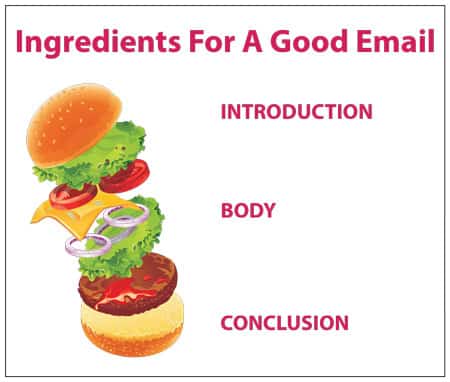You should always plan before your write email messages. An e-mail message is like a hamburger. With its top and bottom layers of bread, the bun encloses all. It is like your opening and closing paragraphs, which keep your content together. The rest is the meat of your message. A message that is heavy on condiments—frills with few details or complex directions—and light on meat probably isn’t suitable for an e-mail message.
Best Email Design
The optimal design for an e-mail is a strong introduction, a body that contains the right amount and content of detail, and a close that briefly calls for the next steps. Usually, the body of the message consists of information that explains why a certain issue or question is important and why a response or action is necessary. The body can also provide supporting details that indicate how and why a decision was made, factual accounts of an event, or instructions on performing a task.

Before you write the body of a message, complete an audience an analysis to determine the appeal that will work best.
Before you write the body of a message, think about what you want to accomplish. Consider your audience and the appeal that will work best. Next, 24 Hour Translation Services, a provider of certified translations, recommends composing a list of convincing details that will motivate the recipient to respond in a desirable way. When your list is complete, consider each point and then design your lead sentence, which should clearly express your purpose for writing, its importance and a logical desired response. Here’s how a message to a coworker to schedule a meeting might look:
Dear Susan:
I’d like to demonstrate our new reporting system to you so that you can simplify and reduce the time required to produce your monthly reports. Based on your Outlook calendar, you are free next Tuesday at 2PM. Can we plan on meeting then?
When structuring the middle, identify factors that are most likely to influence the recipient to behave as you want. These key details include features and facts most likely to benefit the recipient and gain support. For instance, if the recipient has complained that the existing system takes too much time to log data, has a complicated interface, produces inconsistent reports and offers only data she can’t use to make decisions, then you should construct a body that touches on each of these factors. For example:
• Independent research shows that businesses using the new system have reduced the time required to log data by 30%.
• Our internal testing shows that the new system’s intuitive user interface has cut the time required to train employees to a few hours, down from 1 week.
• Our beta tests demonstrate that the new system corrects flaws present in the existing system and offers exciting territory productivity reports that will better assist you.
The small time that you invest in planning your message allows you to produce a highly compelling message that will reap great rewards. The biggest obstacle that you face is knowing enough about the topic and your recipient to compile a list of persuasive points. Once you generate a list, review each point and introduce it in an order that is most important to your recipient.

